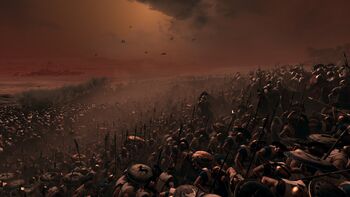Sundering Wars
| Sundering War | |||||||
|---|---|---|---|---|---|---|---|
 Acrean and Symmerian troops clash in present-day Svinia | |||||||
| |||||||
| Belligerents | |||||||
|
|
| ||||||
| Commanders and leaders | |||||||
|
|
| ||||||
| Units involved | |||||||
|
Ancient Symmerian army Ancient Symmerian navy |
Acrean Imperial military Templar Order Arcani | ||||||
| Strength | |||||||
| Presumed millions | Presumed millions | ||||||
| Casualties and losses | |||||||
| Heavy | Heavy | ||||||
The Sundering War, also known as the Acrean-Symmerian War, the Siduri-Eracuran War, or the Great War of Antiquity was a major military conflict between the Acrean Empire and the Symmerian Empire that lasted from 794-826.
After achieving hegemony in the continent of Siduri following the Sabrian Wars in the 7th Century, the Symmerian Empire experienced a period of relative prosperity and peace that continued well into the 8th Century. With peaceful relations established the the Rideva Empire, the sole remaining major power in Siduri, Symmerian traders, merchants, and colonists began pushing across the expanse of Symmerian territory, settling in distant locations and spreading Hellenic culture and philosophy. Although the Symmerians had long regarded the Boreagros, the continent of Eracura, as largely beyond their domain this policy began changing in the 8th Century as Symmerian colonists increasingly pushed into northern Górska. This expansion triggered numerous conflicts with the native Bosrei, many of whom were forced to migrate to escape Symmerian expansionism.
At the same time the Acrean Empire's hold over its far western territories in present day Æþurheim was beginning to weaken as local warlords and tribes pushed for increase autonomy and separation from the rest of the Acrean Empire. The resulting instability led to a sharp increase in crime and violence, leading many Æþurians to look to the sea. The resulting Vikings raids spread across much of the Sanguine Sea, eventually threatening Symmeria itself. Beginning in the mid-8th Century Symmeria began retaliating with punitive expeditions against Æþurheim, which resulted in an increase of tensions between the Acreans and Symmeria over what was seen as Symmerian encroachment into Acrean territory. Coupled with the pressures brought about by the Bosrei migrations, relations between the already wary and suspicious powers broke out into open conflict in 794.
The scale of the war quickly eclipsed that of any prior conflict, fought with larger numbers than any previous war to include the Symmerian-Hannashka Wars, the Discovery Wars, or the Sabrian Wars. The war was typically fought on three "fronts" which included nearly the entirety of southern Eracura and northern Siduri. Protracted naval warfare occurred in the Sundering Sea where both sides vied for control over the critical body of water. Land warfare occurred on a massive scale in the western and eastern portions of both continents. Both sides mobilized resources and manpower from across the domains to support their war efforts. The Acreans fielded predominantly Nordic troops from across the expanse of Eracura, while utilizing foreign mercenaries from other nations. The Symmerians conscripted levy troops from all regions of their empire to include Ruvelkan, Syaran, Mansuri, Shirvani, Adamdar, Biểc, Cham, Hmong, Karvelebi, Sadi, Kazarakhai, Khiyzan, Han, Hayren, Scythian, and Saridak troops. Mercenaries from the Sabrian Empire and Rideva were also employed extensively by the Symmerians, to include the introduction of elephants into Eracura for the first time in history.
Despite the massive forces mobilized, neither side was able to achieve a decisive strategic victory in the conflict. For the first decade of the war, fighting mostly centered around western Eracura marked by Symmerian invasions of Acrean holdings, while a protracted naval campaign was waged in the Sundering Sea. While Symmeria initially enjoyed an advantage at sea thanks to Symmerian Fire, by the early 800s this advantage had largely been mitigated by Acrean counter-efforts. Acrea launched repeated raids into Serikos and Quenmin before finally commencing an invasion of Siduri itself in 807 after gaining the support of rebellious Serikese elements. Symmeria expelled Acrean forces from Siduri in 812, but were themselves defeated in Svinia in 814. A tentative peace was agreed to but had broken down within a year leading to a renewed invasion of Eracura by the Symmerians in 817. Acrean forces raided along the coast into Naran Dahyu, Ruvelka, and Syara itself but an abortive invasion of Naran Dahyu ended in disaster. Symmeria attempted to exploit this debacle by invading the heart of Acrean territory itself in 821, but were decisively defeated in 824.
The war ended without any decisive victor. In 825 the Burning Plague struck Syara and wiped out nearly 25% of the population, leading to an immediate collapse of Symmeria's war effort. Symmeria rapidly withdrew from Eracura save for small holdings in Górska. Acrean efforts to take advantage of this windfall were dashed by the outbreak of open rebellion in the Empire's western holdings, who had suffered heavily in the fighting and had been heavily taxed of manpower and money. Unable to effectively govern their western regions, the Acreans instead opted to withdraw and abandon western Eracura. The Acrean Empire would be officially dissolved over century later.
In Siduri, the effects of the war and the Burning Plague triggered the Crisis of the Ninth Century. Between 825-867 roughly half the Empire's holdings went into open rebellion. Although most territory would be recovered by Aristoxenus, Symmeria would never fully recover. The end of the crisis is used to mark the transition of Symmeria into the Later Symmerian Empire, which gradually lost control of its territory during the Fall of the Symmerian Empire. The devastation of the two empires which would eventually contribute to the end of both has been labeled by modern historians as the "Grand Dissolution" and is often used to mark the end of the "old world" and the beginning of the "Medieval Era".